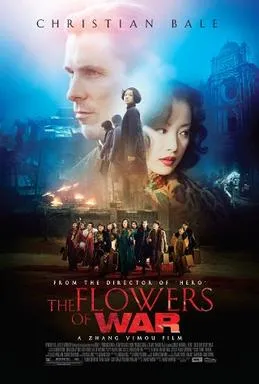Historical accuracy of Flowers of War

Historical accuracy of Flowers of War

Characters
John Miller
Miller is a fictional character, though potentially inspired by the actions of various Westerners who remained in Nanjing during the massacre.
Mo (Yu Mo)
Mo is a central character from the novel the film is based on, representing a group but not a specific historical individual.
Shu
Shu represents the innocent victims of the massacre, particularly the students trapped in the city, but is fictional.
George Chen
George is a fictional character serving as Miller's helper and translator, representing Chinese civilians caught in the conflict.
Major Li
Major Li represents the Chinese soldiers who fought against the Japanese invasion, but he is a fictional creation.
Colonel Hasegawa
Hasegawa is a fictional antagonist representing the Japanese military command responsible for atrocities in Nanjing.
More characters
Father Inglemann
Although priests and missionaries were present, Father Inglemann, whose identity Miller assumes, is fictional.
Dou (Ling Wei)
Like Mo, Dou represents the group of prostitutes but is a fictional character from the novel.
Pu Sheng
Represents the wounded and dying Chinese soldiers left behind during the city's fall, but is a fictional character.
Story
Setting in Nanjing, December 1937
The film is set during the historical Rape of Nanjing (Nanking Massacre) following the city's capture by the Japanese Imperial Army.
Japanese invasion and capture of Nanjing
The Japanese army invaded and captured Nanjing in December 1937 after fierce fighting.
Widespread atrocities by Japanese soldiers
Historical accounts confirm mass killings, widespread rape, looting, and arson committed by Japanese soldiers against soldiers and civilians.
Foreigners remaining in Nanjing to help civilians
Figures like John Rabe and Minnie Vautrin established safety zones and tried to protect civilians; the film reflects this foreign presence.
Civilians seeking refuge in churches/safe zones
Many Chinese civilians sought safety in designated zones, often centered around foreign properties like churches and universities.
Prostitutes sacrificing themselves for schoolgirls
This central plot point, where prostitutes pose as schoolgirls to save them from the Japanese, originates from the novel and is not a documented historical event.
American mortician posing as a priest
The character John Miller and his impersonation of a priest are fictional elements created for the story.
Japanese demand for schoolgirls from the church
Represents the documented targeting and abduction of women for sexual slavery ('comfort women') and assault, though this specific incident is fictional.
Chinese soldiers' desperate defense
Pockets of Chinese soldiers continued to resist the Japanese advance even as the city fell, often fighting against overwhelming odds.
Escape attempt from Nanjing
While the specific escape depicted is fictional, many individuals did attempt perilous escapes from the city during the massacre.
Depiction of brutality and chaos
The film effectively portrays the horrific violence, fear, and chaos that characterized the Nanjing Massacre, aligning with historical descriptions.
Relationship dynamics between the main character groups
The specific interactions and evolving relationships between Miller, the prostitutes, and the schoolgirls are fictional narrative devices.
Setting
Recreation of 1937 Nanjing
The film effectively recreates the look of Nanjing under siege, including destroyed buildings and streets filled with debris and bodies.
Winchester Cathedral setting
While the specific cathedral is fictional, the set design realistically portrays a large Western-style church providing refuge.
Costumes of Chinese civilians/students
The clothing worn by the schoolgirls and other Chinese civilians appears appropriate for the time period and circumstances.
Costumes of prostitutes
The qipaos and makeup, while perhaps stylized for the film, generally reflect common attire for such women in that era's urban China.
Japanese military uniforms/equipment
The uniforms, helmets, weapons, and vehicles used by the Japanese soldiers appear historically accurate for the period.
Chinese military uniforms/equipment
The portrayal of the Chinese soldiers' uniforms and gear, often less standardized than the Japanese, seems accurate for the KMT forces of 1937.
Atmosphere of fear and violence
The film successfully conveys the terrifying atmosphere within Nanjing during the massacre through sound design, visuals, and acting.
Use of multiple languages
The dialogue includes Mandarin, English, Japanese, and the Nanjing dialect, reflecting the diverse groups present in the city at the time.
